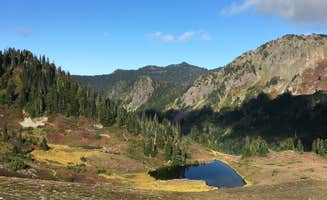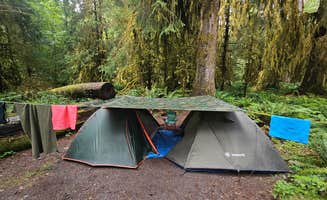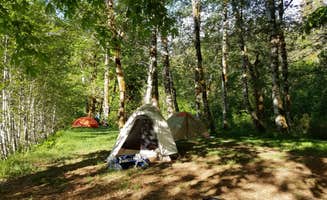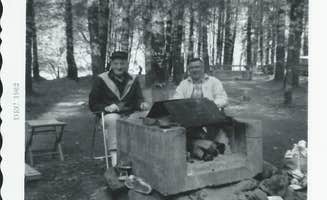Olympic National Park camping ranges from temperate rainforest sites with 140+ inches of annual rainfall to drier coastal campgrounds with frequent fog. The park spans nearly one million acres across three distinct ecosystems, with campground elevations varying from sea level to 3,500 feet. Temperatures can drop below 45°F even in summer months at higher elevation campgrounds, making proper gear essential regardless of season.
What to do
Tidepooling at low tide: Beach access from Salt Creek Recreation Area provides excellent tidepooling opportunities. "There are several ways to access a beach and tide pools during low tide!" notes Kier S. The campground offers spacious tent sites with "great views" according to Brandon J., who adds that "this place has incredible views but also offers plenty of trails and access to viewpoints and tidal areas."
Winter storm watching: Many coastal campgrounds remain open year-round for storm viewing. "I prefer winter camping here because it's less crowded, and the storms coming in from the Pacific are nothing less than awe inspiring," writes Toby R. about Kalaloch Campground.
Rainforest hikes: Trails near Hoh Campground offer immersive rainforest experiences. Kirsten notes, "The trails aren't stroller friendly but easily walkable with toddlers and a backpack. Feels safe. Busy but not like a mall." For serious backpackers, Alison C. recommends the High Divide Loop, saying "The hike itself was beautiful with several waterfalls along the way."
What campers like
Riverside sites: Campsites along waterways are consistently rated highest. "While all the campsites were a bit close on Loop A, we hardly even heard or noticed anyone. It was amazing to fall asleep with the Sol Duc river close by," writes Suzie L. about Sol Duc Hot Springs Resort Campground.
Hot springs access: Several campgrounds offer proximity to natural hot springs. Lucy notes, "The pools are well maintained ($15 to get in), there's locker rooms with showers and there's also a diner. Down the road there's a short 1 mile hike to the falls!" The soaking pools provide welcome relief after hiking, as Marcus K. adds: "Feels especially good after that incredibly long hike I imagined during my afternoon nap."
Wildlife encounters: Elk sightings are common in certain campgrounds. "Lush Green Everywhere! Woke up surrounded by a herd of Red Elk," reports C.A. about Hoh Campground. Bear sightings are also frequent during summer months - Alison C. recounts, "We did see 12 black bears total on our hike, 3 of which were at our campsite. They were busy eating berries and didn't bother us."
What you should know
Weather variability: Olympic camping requires preparation for rapid weather changes. "We were swarmed during the evening while cooking, but they [mosquitoes] died down later at night," notes Graham C. about summer insect activity at higher elevations. At Fairholme Campground, Asuka S. observes: "First night said lowest was 45 but it definitely felt colder. We had our winter sleeping bag but our friends said it was pretty cold."
Campground accessibility: Many campgrounds have limited access for larger vehicles. Laura M. notes about Heart O' the Hills Campground, "Sites were all beautiful but in our RV we were glad to be able to drive around and pick one, rather than reserve one in advance sight unseen, because we need a level spot with at least some sun for our solar."
Reservation windows: Most developed campgrounds in Olympic National Forest fill quickly during summer. Blaine B. advises, "It's one of 3 campgrounds in ONP that you can get a reservation, so be sure to get one unless you're arriving on a weekday." For popular sites, Laura M. recommends: "Cell service is spotty here so you have to rely on the boards with info about open sites."
Tips for camping with families
Kid-friendly facilities: Some campgrounds offer dedicated family amenities. At Elwha Dam RV Park, Jackie S. reports, "Super nice people with allot of amenities. Play equipment for the kids along with family outside & inside games. They offer free produce to the campers from their garden & free movie rentals."
Wildlife viewing opportunities: Specific campgrounds offer reliable wildlife sightings. At Hoh Campground, Shari G. describes: "Imagine wandering down the trail in the middle of this mass of life and observe a herd of Elk browsing on this herbivore salad bar. It's exceptional."
Swimming access: Several campgrounds feature lakes safe for children. Beatriz S. notes about Fairholme Campground: "The campground is right by the lake and offers walk-in sites that are literally on the lake shore. The best site in my opinion is 72, which is not directly on the lake shore but has a great view and good tree coverage."
Tips from RVers
Dump station locations: Limited dump stations make planning essential. Laura M. notes, "There's a dump station and water fill near the boat ramp" at Fairholme Campground, while also advising about access challenges: "This is a beautiful campground with 4 loops- I would say loop D is most accessible for RVs. The entrance to B was steep and we didn't even want to risk it."
Site selection strategy: Developed campgrounds have varied site configurations. Sol Duc campground reviewer Marcus K. notes: "Has three sections among the big trees. We had the joy of moving from campsite to campsite while we spent 3 nights. Sites vary in size. Some are tiny and cramped up to your neighbor and some are large and private. Some back ins and some have pull throughs."
Road conditions: Access roads to remote campgrounds can be challenging. Sarah S. warns about Graves Creek: "The road getting there is a bit narrow and bumpy which was made even more exciting by the fact that it was dark and rainy." For camping in Olympic National Forest, preliminary scouting of access routes is recommended during daylight hours.













